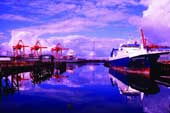Shipshape wireless

Project clears steel hulls and asbestos hurdles.
In times of wars or emergencies, it falls on the Maritime Administration to ensure that U.S. cargo vessels are ready to serve. The logistics role the merchant ships play for the Pentagon is a key aspect of the country's defense strategy.To better perform that function, the 44 ships in the fleet were outfitted with modern, wired computer networks that are designed to be able to easily add wireless capabilities, said Donna Seymour, the agency's chief information officer. The networked ships support logistics systems and communicate with bases onshore, she added."This is not only good for what we need to do from a military-readiness perspective, but it also means a lot to the crews aboard the ships as far as quality of life and being able to communicate shore-side," she said.Stanley Inc. of Arlington, Va., and its subcontractor Federal Concepts LLC of Stevensville, Md., worked together on the project."The ships did not have consistent networks, so the first phase of the project was to go through and put common networks on all the ships," said Thames Hillman, Stanley's on-site program manager. The networks included desktop computers and servers."At the same time, we did wireless access points" Hillman said. "We figured we might as well prepare for it since we already sent teams out to each of the ships."Having both wired and wireless networks is advantageous, but installing them onboard ships was tricky. Some ships had asbestos components, so drilling and running cables through bulkheads required precision to avoid releasing harmful materials or compromising the vessel's structural integrity.Another challenge was delivering power to wireless access points distributed throughout the ships, said Eric Wolking, vice president of federal agency programs at Stanley.Stanley took advantage of power-over-Ethernet technology to solve some of the issues, he said. "We bought switches that basically supply power over Ethernet to devices," he said.Because wireless signals don't go through metal well, technicians had to carefully select access point locations.When the ships are at sea, they communicate via various satellite connections, and other broadband options are often available when they're in port. To ensure that communications always use the most cost-effective connectivity, the vendors installed devices from SeaWave LLC that automatically select the most efficient connectivity available."The SeaWave Integrator takes into account what communications paths are available, how big the communication is that needs to go across the medium and how long then each communication path would take," Seymour said.With the new onboard networks, managers at the Maritime Administration can view logistics and vessel information nightly."We used to get that information monthly because the vessels had to zip up their databases, put them on a CD and mail them in," Seymour said.The new system even lets ships share information with one another. If one vessel needs a particular pump for a repair part, the network can identify a vessel that might have one available.The new network also enables technicians to manage onboard computers and servers remotely.The added support enables the ships to better perform their daily duties and ensures that they are ready for emergencies."When our vessels are out on a military mission, we must maintain communications," Seymour said.

Staff writer Doug Beizer can be reached at dbeizer@1105govinfo.com.

U.S. merchant ships can communicate to shore with new networks.
Newscom
Staff writer Doug Beizer can be reached at dbeizer@1105govinfo.com.
NEXT STORY: Thinking outside the military box